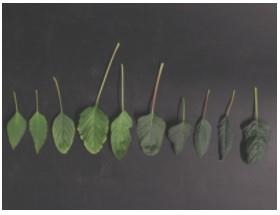Sarah Kezar evaluating and observing Palmer amaranth in the lab. Palmer amaranth is a weed that is invading crops, stealing their nutrients and sunlight. Kezar recently presented her research about the weed at the 2021 ASA-CSSA-SSSA Annual Meeting.
But it’s not just our crops that will be affected. For as long as humans have farmed crops, we’ve also fought weeds. These pesky plants fight for water, light and nutrients with the crops we use for food. By their very nature, weeds are typically more robust than domesticated crops. How will the permanent race between weeds and crops change in a warming world?
“The response of crops to anticipated changes in temperature and available water has been well documented, but little has been studied with weed species,” she says. So, to complement research on the changing growing conditions for crops, Kezar and her team have been focusing on how weeds will adapt as well. They’ve discovered that pernicious weeds may grow stronger compared to most crops.
That’s not good news. But the knowledge of weeds’ strengths can help scientists plan for better ways to combat them as our world continues to change. Kezar presented her research at the 2021 ASA-CSSA-SSSA Annual Meeting, held in Salt Lake City.

Comparison of Palmer amaranth leaves from no temperature and moisture stress (left) to increasing temperature and moisture stress (left to right). Kezar’s research found that this weed is especially tolerant to various weather conditions – helping it compete against food crops.
Kezar explained how Palmer amaranth grows in hotter and drier conditions like those the U.S. faces in the future. Palmer amaranth is a giant weed, growing over six feet tall if left unchecked. The weed can produce as many as a million seeds from a single plant. It originally hails from the desert Southwest. But it has recently spread far and wide, reaching 28 states. Palmer amaranth’s range is likely to expand as the warm conditions it prefers spread northward.
To assess how Palmer amaranth will fare in the future, Kezar set up an experiment under highly controlled conditions. She tested growth at four different temperatures, which ranged up to daily high temperatures of 104 degrees Fahrenheit. Kezar also varied how much water the weed received, to simulate wetter and drier conditions.
“Palmer amaranth growth was affected by elevated temperature and moisture stress conditions in terms of magnitude, but this weed was still able to grow,” says Kezar. “The fact that Palmer amaranth…maintained adequate growth under high temperature and moisture stress shows that Palmer amaranth can still remain highly competitive by exhausting soil water and nutrients available to crops to impact yield.”
Click here to see more...